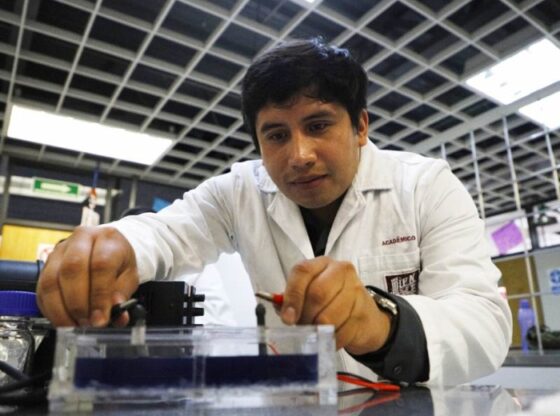IPN students seek this technology to eliminate most of the organic and inorganic matter present in wastewater. To do this, it uses sargassum, which affects Mexican beaches so much.
Mexico City, November 17 (However).– A group of students of the National Polytechnic Institute (IPN) has carried out a project to use the sargasso –an algae that floats in the seas and usually hits the coasts of Mexican beaches– in a process carried out by wastewater decontamination.
The group of IPN students, at the postgraduate level, made electrodes that they use in an electrochemical process to degrade contaminants from the textile industry. These electrodes were generated from charcoal extracted from sargassum.
The young polytechnics have already successfully tested the electrodes at a semi-pilot level, detailed the IPN, by removing contaminants from waste water provided by a textile company, which contains pigments from the dyeing of denim.

The indigo color is very difficult to remove from wastewater, which is why conventional treatment processes are often incomplete. For this reason, IPN students seek this technology to eliminate most of the organic and inorganic matter present in this water.
The young people, advised by scientist Jorge Alberto Mendoza Pérez, apply a technique called pyrolysis to dehydrated sargassum, through which the algae is chemically transformed through a thermal process at high temperatures and specific operating times until obtaining a solid fraction, known as Biochar or vegetable charcoal.
Subsequently, they add special catalysts developed by them to the Biochar to modify the initial amorphous sizes and ensure that the carbon nanotubes and graphene have uniform nanometric sizes.
In addition, they “characterize” the nanometric biochar and apply different techniques to verify that the particles have the appropriate nanometric size (thickness, diameter and length) to manufacture the electrodes with better electrical conduction properties than other commercial devices.


When manufacturing the electrodes, they add some semiconductors to the biochar and subject this formulation to a thermal process so that the electrical conductors acquire the specific hardness to properly carry out the electrochemical process. Finally, they corroborate that they comply with quality parameters based on international standards.
The group of IPN students is made up of Geovani Flores Sánchez, Frida López López, Ángel Eduardo Lugo Dorantes and José Fernando Carmona Neri. All of them are studying the Master’s Degree in Sustainability of Innovation in Environmental Technology, taught by the National School of Biological Sciences (ENCB).
This is an interdisciplinary project that seeks new uses for sargassum – which usually occurs on Mexican beaches – under sustainable principles, which is one of the policies of the IPN and the Mexican Government.
And since 2011, the beaches of the Caribbean Sea, from the Antilles to the Dominican Republic, passing through the coasts of Yucatan, receive thousands of tons of sargassum every year starting in the spring.
#IPNInforma | Using charcoal extracted from sargassum, graduate students from the @IPNENCB They make electrodes that they use in an electrochemical process to degrade contaminants from the textile industry. ♻️
— IPN (@IPN_MX) November 16, 2025
When floating on the high seas, sargassum provides a favorable habitat for many species. But when it invades the beaches, they decompose, emit a gas that smells like rotten eggs and is dangerous to health if it reaches high concentrations, and they suffocate several species that do not receive light from the surface.
The natural phenomenon caught the attention of scientists around the world: it broke out abruptly in 2011 and has been repeated every year since then. Historically, the mass of sargassum was concentrated in the North Atlantic, in the so-called Sargasso Sea, well known to navigators and mentioned by Christopher Columbus.
Year after year, the arrival of sargassum constitutes an environmental and economic challenge. Cleaning beaches costs millions of dollars. So to confront the problem, Mexico inaugurated an environmental and sargassum monitoring center in June, based in Cancún.


“The vision of Geovani Flores, Frida López, Angel Lugo and Fernando Carmona is to generate a comprehensive system, therefore, with the purpose that the polytechnic technology implicitly carries the seal of sustainability, they incorporated solar panels into the process, which provide the necessary energy to the system to carry out decontamination,” explained the IPN.
This team of young Mexican scientists won first place in the InnoDrop Water Talent Incubator, which promotes the ideas of innovation leaders and recognizes their spirit of entrepreneurship focused on solving the main water security challenges facing Mexico.
Now, with the seed capital obtained, they will incubate the project with the aim of bringing these electrodes to the industrial sector.

